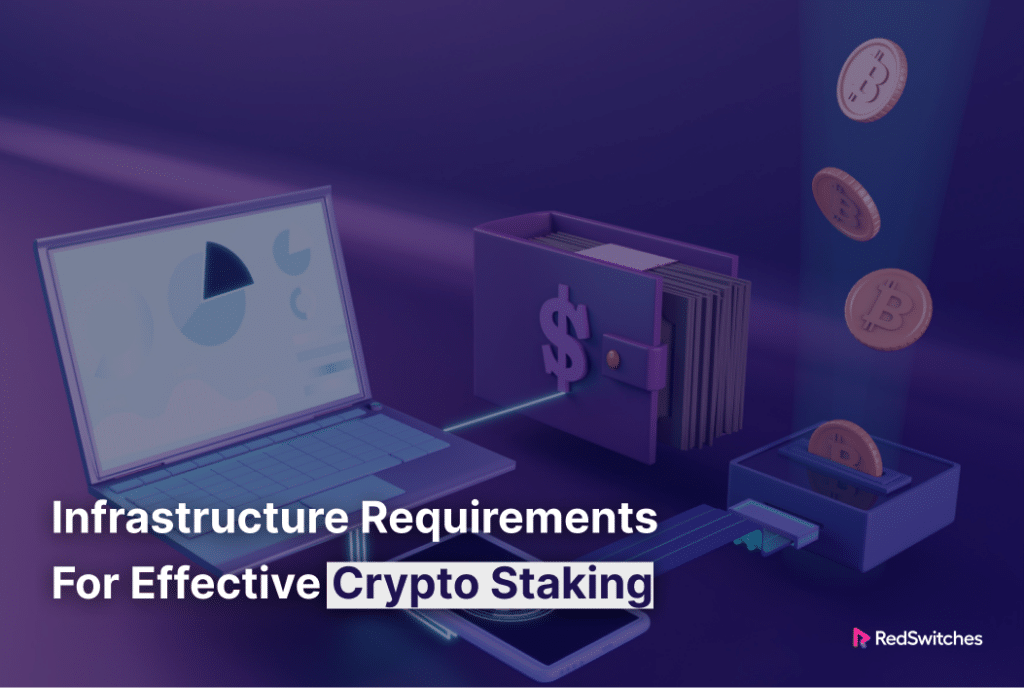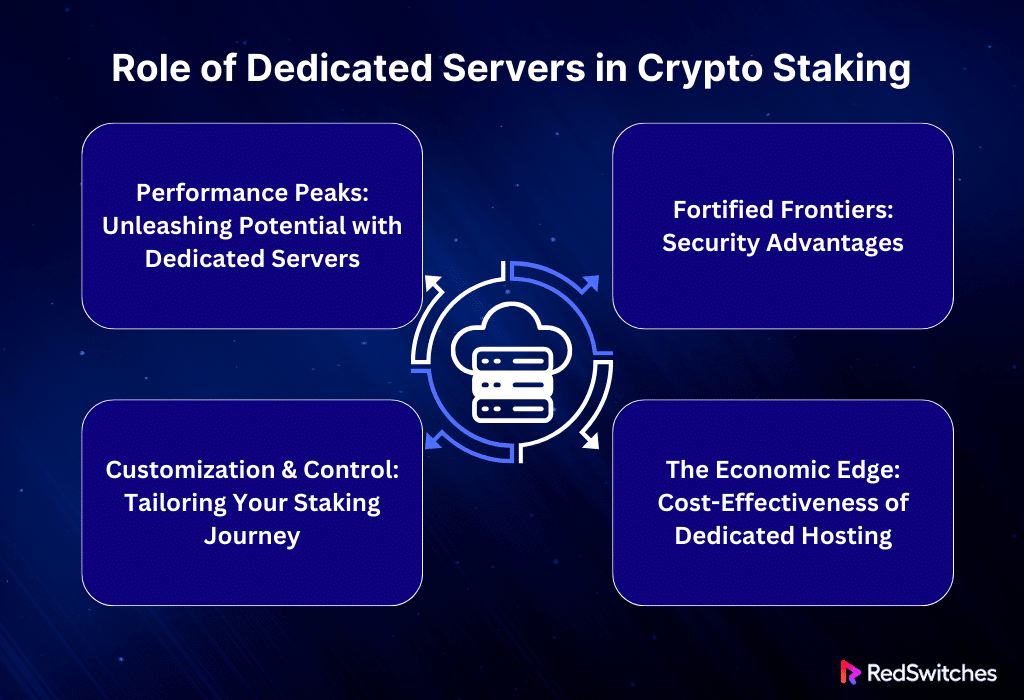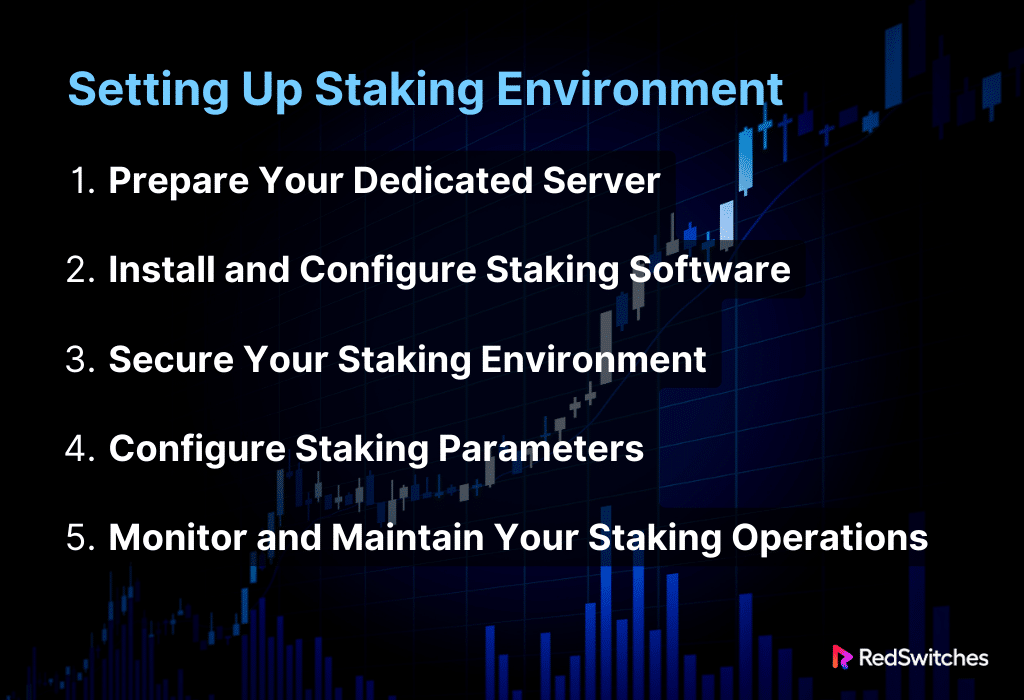Key Takeaways
- Staking in cryptocurrency is the practice of participating in network validation while reaping benefits by holding and locking up coins.
- Staking uses a variety of approaches, including delegation, liquid staking, pooled staking, and validator nodes.
- Essential infrastructure requirements for crypto staking includes dedicated hosted servers with ample RAM, processing power, memory, etc.
- Dedicated servers provide stability, security, and great performance in staking environments.
- Choosing the correct dedicated hosted server is critical for increasing staking returns while reducing risks.
- RedSwitches provides dedicated hosted server solutions designed specifically for crypto staking, ensuring dependable infrastructure and peak performance.
As the crypto market matures, staking has become popular, with over 31.4M of Ethereum staked, according to recent statistics by Coinbase. This considerable figure shows the growing importance of having a strong infrastructure to support the demands of effective crypto staking. The amount of Ethereum staked fluctuates regularly, so it’s best to check current sources for the most up-to-date figures.
Understanding the infrastructure requirements and the need for the best dedicated server solutions is crucial for those looking to enter the crypto staking space. This blog will discuss the infrastructure requirements for crypto staking, helping you ensure you begin your staking journey backed by the best infrastructure.
Table of Contents
- Key Takeaways
- What Is Staking?
- Different Ways of Staking
- Infrastructure Requirements for Crypto Staking
- Role of Dedicated Servers in Crypto Staking
- Choosing the Right Dedicated Server for Staking
- Setting Up Staking Environment
- RedSwitches’ Dedicated Server Solutions for Staking
- Conclusion – Infrastructure Requirements for Crypto Staking
- FAQs
What Is Staking?
Credits: FreePik
Before we discuss the infrastructure requirements for crypto staking, it is important to understand what crypto staking means.
Cryptocurrency staking is similar to earning interest in a savings account. When you stake your digital assets, you lock up your coins or tokens to support the process and security of a blockchain network. In return for dedicating your assets and helping to validate transactions, you gain rewards, generally in the form of more coins or tokens.
Wondering how does staking work? Here’s the answer:
- Holding Cryptocurrency: First, you must own a cryptocurrency supporting staking. Not all cryptocurrencies offer staking, so it’s important to research and hold one that does.
- Locking Your Assets: Once you have the appropriate cryptocurrency, you ‘stake’ it in a wallet or on a staking platform like Gemini, Kraken, or Binance. This act of locking helps to secure the network because it makes it expensive for anyone to attempt fraudulent activities.
- Participating in Network Operations: You are participating in the network’s operations by staking your assets. Depending on the blockchain, your staked assets can be used to add new blocks to the blockchain, validate transactions, or support the network in other ways.
- Earning Rewards: You receive incentives for staking your assets and supporting the network. These benefits are often a proportion of your staked amount, paid in the same cryptocurrency.
Do you want to learn about the different types of staking? Read our informative blog, ‘Guide To Types Of Crypto Staking: Risks, And Platforms 2024.’
Different Ways of Staking
Although the fundamental concept of staking involves locking crypto assets to support network operations, there are numerous ways to engage in this process. Understanding them can offer valuable insight into which staking method is most suitable for you. Here are the different ways of staking:
Delegation
Delegation is one of the most basic types of staking for those who want to receive staking benefits without the hassle of maintaining their own validator node. This solution allows crypto holders to delegate their coins to a validator, a network participant in charge of validating transactions and maintaining the blockchain.
The validator then uses the pooled resources to participate in the network’s consensus process. Delegators receive a portion of the benefits earned by these actions in proportion to their staked assets, while validators are paid a modest commission for their services.
Advantages
- Requires minimal technical knowledge.
- Lowers the risk as experienced validators handle the actual management of the staked assets.
- Provides a passive income stream without the need for dedicated hardware.
Liquid Staking
Liquid staking is a fairly new innovation that allows stakeholders to keep their assets liquid when staked. When users stake their assets using liquid staking protocols, they acquire representative tokens, sometimes known as “staked tokens” or “liquid staking tokens.”
These tokens can then be used for other DeFi operations like trading, lending, and collateral. This enables users to use their staked assets without having to unstake them.
Advantages
- Offers liquidity, allowing users to use their staked assets in various DeFi applications.
- Improves capital efficiency by allowing staked assets to perform numerous functions simultaneously.
- Often provides added staking rewards through the activities conducted with the liquid staking tokens.
Pooled Staking
Pooled staking is a strategy in which numerous stakeholders pool their assets to improve their chances of being picked to validate transactions and collect rewards. This solution is especially useful for smaller stakeholders that lack the resources to host a complete validator node independently.
By pooling their resources, they may achieve the minimal staking criteria and reap benefits proportional to their contribution to the pool.
Advantages
- Democratizes the staking process, allowing smaller holders to participate and earn incentives.
- Minimizes the technical barriers to entry, as the pool operator usually manages the validator node.
- Participants receive a more predictable and stable return, as rewards are distributed across the pool.
Validator Nodes
Using a validator node is a more active and technical method of staking. In this architecture, people or entities run a node actively participating in the blockchain’s consensus process. This includes verifying transactions, proposing new blocks, and ensuring the network’s integrity.
To become a validator, one must often stake a considerable number of the blockchain’s native tokens as collateral, satisfying the network’s minimum requirement.
Advantages
- Offers higher potential rewards, as validators receive transaction fees and block rewards.
- Gives direct participation in the blockchain’s governance and consensus processes.
- Improves the decentralization and security of the network, contributing to its overall health and stability.
Also Read: What Is Staking Crypto? How To Earn Crypto Rewards.
Infrastructure Requirements for Crypto Staking
Credits: FreePik
The secret to successful staking operations lies in the infrastructure that supports them. High-performance dedicated hosted servers play a crucial role in this setup. Here are some of the essential infrastructure requirements for crypto staking:
High-Performance Processors
Any high-performance dedicated hosted server is built around a CPU. Powerful processors are among the key requirements for crypto staking, as transactions must be handled swiftly and effectively. High-performance processors accelerate blockchain transactions, allowing for speedier consensus and improving the entire staking process.
These processors can handle the complex computations needed to validate transactions and blocks, making them a must for staking activities.
Scalable Storage Solutions
Blockchain networks can grow immensely, demanding more storage space for the ledger and transaction data. This makes scalable storage solutions a must-have. These solutions help increase storage capacity as the network expands, ensuring the server can efficiently maintain the entire blockchain and operate without running out of space.
Energy-Efficient Power Supply
Crypto staking, especially on an extensive scale, can consume large amounts of energy. This makes an energy-efficient power supply among the top infrastructure requirements for crypto staking.
An energy-efficient power supply is crucial to lowering operational expenses and reducing the negative environmental impact. Investing in green energy solutions or energy-efficient hardware can foster more sustainable stakeholder practices.
Ample RAM (Random Access Memory)
RAM is another important element in infrastructure requirements for crypto staking. Abundant RAM ensures the server can handle numerous jobs simultaneously without slowing down. In crypto staking, the server effectively manages the staking software, keeps the blockchain in good condition, and processes transactions quickly.
The more RAM accessible, the more resilient the server may be in meeting demanding needs, boosting performance and dependability.
High-speed Network Connectivity
Staking in a blockchain setting requires ongoing contact with the network and other staking nodes. High-speed network access is necessary to ensure this communication runs smoothly and uninterrupted. Fast network connections reduce transaction verification and block propagation time, which is crucial in ensuring a node’s relevance and efficacy in the staking process.
Robust network connectivity also helps synchronize with the blockchain, ensuring the staked assets effectively add to the network’s protection and consensus mechanisms.
RAID Configurations
Data integrity and protection are essential requirements for crypto staking, where financial assets are at stake. RAID (Redundant Array of Independent Disks) configurations safeguard data against hardware failures by distributing data across multiple disks. RAID ensures continuous operation by providing redundancy, even if one disk fails.
This redundancy is vital for staking servers, as it minimizes downtime and prevents loss of staking rewards due to hardware malfunctions. Implementing RAID configurations enhances the reliability of the staking infrastructure, ensuring that data integrity is maintained and the staking operations can continue without interruption.
Software and Tools for Management
Effective staking demands appropriate hardware, software, and tools to control the process. This covers blockchain node software, staking programs, and monitoring tools for monitoring the server’s performance and staking activities. These tools help optimize the staking process, manage rewards, and ensure the system’s health and performance.
Technical Support and Maintenance
24/7 technical support and ongoing maintenance are requirements for crypto staking. These features help address issues and ensure the infrastructure stays operational and updated. Regular updates and maintenance help avoid or address vulnerabilities, minimize the risk of system failures, and ensure that the staking operations follow the latest security standards and network protocols.
Role of Dedicated Servers in Crypto Staking
As stated above one of the most important requirements for crypto staking are high performance dedicated hosted servers. Why is that? Here we discuss the role of dedicated hosted servers in crypto staking:
Performance Peaks: Unleashing Potential with Dedicated Servers
One key benefit and reason why high-performance dedicated hosted servers are among the infrastructure requirements for crypto staking is increased performance. With dedicated resources, stakeholders can run their operations without the risk of slowdowns or outages, which are common with shared hosting solutions. This performance dependability is critical for preserving a validator’s status in the network, as downtime can result in missed blocks and penalties.
Fortified Frontiers: Security Advantages
Security is a priority in cryptocurrency, and dedicated hosted servers provide more robust security. Using a server purely for staking activities considerably decreases the possibility of cyber attacks. Users can protect their staking operations against harmful assaults using specialized security measures like firewalls, anti-malware systems, and intrusion detection.
Customization and Control: Tailoring Your Staking Journey
Another key advantage of considering dedicated hosted servers as requirements for crypto staking is the ability to customize and manage the server environment. Users can modify their server settings, network setups, and preferred staking software to meet their requirements. This customization is unavailable with shared hosting services, requiring customers to stick to the provider’s default settings.
The Economic Edge: Cost-Effectiveness of Dedicated Hosting
While dedicated hosted servers can seem like a substantial expenditure, their advantages over time make them cost-effective. Dedicated hosted servers can manage large transaction volumes, ensure stable uptime, and increase staking payouts while minimizing losses due to provider failures. This makes them an economically viable alternative for serious investors seeking to optimize their profits.
Also Read: Automated Staking Scripts and Tools for Server-based Nodes
Also Read: What Is the Minimum Lockup Period for Crypto Staking?
Choosing the Right Dedicated Server for Staking
Credits: FreePik
Several server options are available for crypto staking, each fulfilling varying requirements. While one server may fulfill the requirements of one individual, the other may be best suited for another. Here are various dedicated hosted server options tailored for staking:
Importance of Server Specifications
Choosing a dedicated hosted server for staking is more than picking a powerful machine. It involves identifying the unique needs of your staking activities, including processor power, memory, storage capacity, and network bandwidth. The ideal server should meet the needs of the blockchain network on which you intend to stake, ensuring that it can perform transaction validations, block construction, and network connectivity efficiently and consistently.
Examining Different Server Options
Here are a few server options you can consider that fulfill the infrastructure requirements for crypto staking. Go over the specifications of each server to understand which fulfills your unique requirements for crypto staking:
-
AMD EPYC 7402 Server – €639.00
The AMD EPYC 7402 server is a powerhouse for demanding staking applications with unrivaled processing power. Here are some of its specifications:
Specifications
- CPU: 48 Cores/96 Threads @2.6Ghz, 96 virtual Cores
- Memory: 256 GB DDR4
- Storage: 4×960 GB SSD
- Network: 1 Gbps
- Bandwidth: 100TB
Best for
This server is ideal for high-performance staking operations that demand extensive processing power and substantial memory. Thanks to its extensive core count and high-speed SSDs, it is highly recommended for large-scale staking on networks with high transaction volumes. The considerable bandwidth allowance accommodates significant network activity, making it a robust choice for intensive staking tasks.
Also, Buy A Dedicated Server With Bitcoin At The Lowest Price.
-
Intel E-2286G Server – €199.00
The Intel E-2286G server is a reliable and efficient option perfect for getting started with staking. Here are some of its specifications:
Specifications
- CPU: 6 Cores/12 Threads @4.0Ghz, 12 virtual Cores
- Memory: 64 GB DDR4
- Storage: 2×480 GB SSD
- Network: 1 Gbps
- Bandwidth: 30TB
Best for
This server balances processing power and cost-efficiency. It is ideal for small to medium-scale staking operations. Its solid performance credentials are sufficient for emerging stalkers who need a reliable but not excessively robust infrastructure.
-
Intel E5-2620v4 Server – €299.00
The Intel E5-2620v4 server is a solid middle-ground for those seeking affordability with performance. Here are some of its specifications:
Specifications
- CPU: 16 Cores/32 Threads @2.1Ghz, 32 virtual Cores
- Memory: 64 GB DDR4
- Storage: 2×480 GB SSD
- Network: 1 Gbps
- Bandwidth: 30TB
Best for
This server is meant for medium-scale staking operations that demand moderate processing power and memory. It offers a blend of performance and cost. This makes it perfect for established staking environments with moderate activity levels.
-
AMD EPYC 7302P Server – €169.00
The AMD EPYC 7302P server is economical and doesn’t compromise speed and efficiency. Here are some of its specifications:
Specifications
- CPU: 16 Cores/32 Threads @3.0Ghz, 32 virtual Cores
- Memory: 64 GB DDR4
- Storage: 2×480 GB SSD
- Network: 1 Gbps
- Bandwidth: 2TB
Best for
This server is a cost-effective solution for individuals or small teams focusing on efficiency and budget-friendly operations. It provides a robust foundation for staking and has received positive performance reviews.
-
Intel Xeon E5-2620v4 Server – €219.00
The Intel Xeon E5-2620v4 server is a balanced server option, providing a stable environment for various staking activities. Here are some of its specifications:
Specifications
- CPU: 16 Cores/32 Threads @2.1Ghz, 32 virtual Cores
- Memory: 64 GB DDR4
- Storage: 2x500GB SSD
- Network: 1 Gbps
- Bandwidth: 5TB
Best for
This server offers a balanced profile with good processing power and storage capacity, making it suitable for small to medium-sized staking projects. It provides a reliable infrastructure for staking operations, ensuring a steady performance.
These are just some examples, and many other server options in the market may be suitable for different staking needs.
Note! You can check and choose your required servers and more at RedSwitches.
Setting Up Staking Environment
The next step is to set up the staking environment after deciding on dedicated hosted servers as infrastructure requirements for crypto staking. This process involves preparing the hardware, installing the software, and ensuring everything is optimized for efficient and secure staking. Here’s a step-by-step guide to setting up your staking environment:
Prepare Your Dedicated Server
Once you have decided on dedicated hosted servers as infrastructure requirements for crypto staking, it’s time to prepare them. This involves:
- Initializing the Server: Configure the BIOS settings and set up the RAID configurations if needed to ensure optimal performance and data redundancy.
- Installing the Operating System: Pick a stable and secure Operating System (OS) compatible with your staking software. Linux distributions are often preferred for their reliability and security features.
- Setting Up Network Configurations: Assign a static IP address, configure the firewall settings, and ensure the network is secure and can manage the data flow needed for staking operations.
Install and Configure Staking Software
- Download the Software: Visit the cryptocurrency’s official website for the official staking software. Ensure the version you download is appropriate for the operating system on your server.
- Install the Software: Follow the installation instructions supplied by the software makers. This could include GUI installation procedures or command-line activities.
- Synchronize the Blockchain: Your node may take some time to download and validate the complete blockchain before you can begin staking. Ensure your server has enough network bandwidth and storage to do this task quickly.
Secure Your Staking Environment
- Update the Server: To guard against vulnerability, keep the operating system and any relevant applications up to date on a regular basis.
- Implement Security Measures: Use strong passwords for all accounts, set firewall rules to prevent unnecessary access, and consider using added security measures like two-factor authentication.
- Backup Data: Regularly backup your wallet and other important data. Ensure backups are stored securely in multiple locations to prevent loss due to hardware failure or other issues.
Configure Staking Parameters
- Set Up the Wallet: Create a wallet, particularly for staking. Transfer the cryptocurrency you wish to stake into this wallet.
- Initiate the Staking Process: Follow the steps specific to your chosen cryptocurrency to begin staking. This may involve locking the funds in your wallet, running a command, or clicking a button in a GUI (graphical user interface).
Monitor and Maintain Your Staking Operations
- Regular Monitoring: Keep track of the performance and status of your staking operations. Use monitoring tools to monitor the health and efficiency of your staking environment.
- Maintenance and Updates: Conduct regular maintenance on your server’s hardware and software. Update the staking software and server operating system as new versions become available to ensure continued security and efficiency.
Also Read: 7 Best GPUs For Mining In 2024.
Also Read: Cost-benefit Analysis of Crypto Staking Using Dedicated Servers
RedSwitches’ Dedicated Server Solutions for Staking
RedSwitches has become a renowned provider of the best dedicated server solutions specifically optimized for crypto staking. Their offerings are designed to meet the high demands of blockchain applications, ensuring that clients have the necessary infrastructure to engage in staking activities successfully.
High-Performance Dedicated Hosted Servers
RedSwitches’ offerings are built around high-performance dedicated hosted servers powered by the newest Intel Xeon or AMD EPYC CPUs. These resilient CPUs are required for the computational needs of crypto staking, allowing for faster transaction verification and processing. In addition to processing power, these servers have enough RAM, allowing for fast multitasking and quick staking operations.
Another important factor is storage, and RedSwitches takes no shortcuts on this front by providing NVMe or solid-state drive (SSD) options. These technologies offer low latency and quick data access, which is essential for staking where responsiveness and speed are crucial. Standard features include high-speed network connectivity, making communicating with other staking nodes and the blockchain network easy.
RedSwitches implements RAID configurations for uptime and data protection. This helps protect against disk failures and ensures continuous operation, which is vital for uninterrupted staking.
Also Read: What Is Cryptojacking & How To Prevent It?
Quick and Efficient Setup
Credits: Freepik
RedSwitches offers a speedy setup procedure because it recognizes the need for rapid deployment. It eliminates wait times linked to hardware purchase and setup using the newest AMD and Intel CPUs across its server line. There are no startup fees or hidden expenditures, making the switch to staking hassle-free. This also offers peace of mind to those trying out its services for the first time.
Comprehensive Support and Management
RedSwitches stands out for its free server management solution, which allows clients to focus on staking rather than server administration. They provide over 20 worldwide server locations, allowing clients to select geographically appropriate servers for maximum performance and latency.
Clients can access omnichannel assistance through email, WhatsApp, Live chat, phone, Skype, and Telegram. This extensive support network ensures clients’ concerns are resolved quickly and efficiently.
User-Friendly Server Management
RedSwitches offers an easy-to-use server user interface to help you manage your dedicated hosted server. This application enables customers to monitor and control their server’s performance, making necessary changes to optimize their staking activity. It is simple to use, even for those with little technical knowledge, making the tool accessible to everyone.
Conclusion – Infrastructure Requirements for Crypto Staking
Fulfilling the right infrastructure requirements for crypto staking can make all the difference. The need for high-performance, secure, and dependable hosting solutions is undeniable in this space. RedSwitches is a reliable hosting provider for crypto stakers.
They offer affordable dedicated server solutions that meet the demands of crypto staking. Their dedicated hosted servers are engineered to provide the optimal balance of performance, security, and uptime, ensuring that your staking efforts are fruitful and uninterrupted. So what are you waiting for? Visit our crypto dedicated server page here, and order your server today!
FAQs
Q. What do you need to stake crypto?
To stake crypto, you need a compatible cryptocurrency, a digital wallet to hold your coins, and access to a staking pool or a blockchain platform that supports staking if you prefer to stake independently.
Q. What is a staking requirement?
A staking requirement refers to the minimum amount of cryptocurrency held in a wallet to participate in staking and any specific conditions set by the staking platform, like time commitments or technical specifications. Infrastructure requirements for crypto staking include having powerful CPUs and dedicated hosted server capabilities.
Q. What is crypto staking?
Crypto staking is the process of actively participating in transaction validation on a blockchain network by staking your crypto assets to earn staking rewards.
Q. How does staking in crypto work?
Crypto staking work involves holding a certain amount of cryptocurrency in a compatible staking wallet to support the network’s consensus mechanism and earn rewards.
Q. What are the risks of staking crypto?
The main risks of staking include potential loss of staked assets due to network vulnerabilities or technical failures in the staking process.
Q. What are the benefits of staking?
Staking offers various benefits such as earning passive income, participating in network governance, and contributing to the security and decentralization of the blockchain network.
Q. How can I earn more crypto through staking?
By staking more crypto and participating in staking pools or staking platforms, you can increase your chances of earning higher staking rewards.
Q. Is staking a way to earn passive income?
Yes, staking is a way to earn passive income by holding and staking your crypto assets to receive staking rewards over time.
Q. What are the best staking platforms for cryptocurrency?
Some of the best staking platforms offer secure and user-friendly interfaces, competitive staking yields, and various staking offers to help you maximize your earning potential.
Q. Can I delegate staking to earn crypto rewards?
Yes, you can delegate staking to a validator or a staking pool to earn crypto rewards without managing the hardware and software required for staking yourself.
Q. What is Staking Infrastructure?
Staking infrastructure refers to the hardware, software, and network components necessary for participating in blockchain staking. It ensures secure and efficient transaction validation and block creation.










